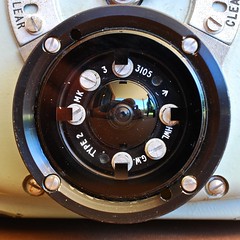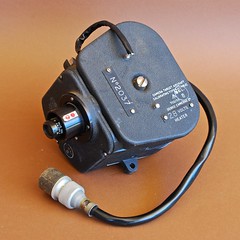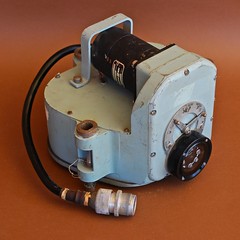User:Heritagefutures/WorkSpace3
Contents
Missile Stuff
Missile Cameras
Cameras played a major role in documenting the experiments and testing carried out the early days of guided weapons development. A suite of specialised cameras were developed in the mid- to late 1950s by various U.S. manufacturers, by Soviet camera makers and by the Royal Aircraft Establishment in the UK.
In Australia, the Weapons Research Establishment (South Australia) designed such cameras as part of the Anglo-Australian Joint Project (1946 to 1980) which focussed on guided weapons and missile development. The research focussed on a missile's behaviour in flight relying on observation and general telemetry data. While the latter would be displayed on an cathode-ray oscilloscope in real time, they needed recording to allow for detailed analysis. Film was a suitable medium to record such transitory analog data. To this end, high-speed cine cameras were developed which capable of 100 frames/second and more. While recorded data would be viewed as segments of motion film many were analysed on a frame-by-frame basis.
In principle, cameras were developed for four different applications: ground-based cameras for observation and the recording of the telemetry, and airborne cameras, either borne by the missile or carried by the target.
Ground based cameras
Missile behaviour
- Telemetry recording
Recording of moving Oscillograph data occurred principally with the GW 3 camera. Such cameras also existed in the civilian arena (such as the Cossor 1428).[1]
Airborne cameras
Missile-borne cameras
Target Aircraft Cameras
Notes
- ↑ The Fairchild F-296 is an example of camera used to record stable oscillograph data where a single image sufficed for the purposes documentation.
| FEEL FREE TO LOOK, BUT PLEASE DO NOT TOUCH... |
GW cameras

|
| Dekko GW 1 Mk 1A image by Dirk HR Spennemann (Image rights) |
During the early period of the Cold War the United Kingdom carried out wide-ranging missile research, partly in collaboration with Australia (under the umbrella of the Anglo-Australian Joint Project, which ran from 1946 to 1980). [1] The testing of the missiles required a range of sophisticated devices to record and document missile behaviour in flight, approaches to targets and also to record telemetry data that were obtained on the ground. In the days prior to digital data collection this occurred analog, with film being the preferred option. All cameras carry the type specification GW for Guided Weapons. While technically most of the cameras where high speed cine cameras (100 frames/second), many of them were used for frame-by-frame analysis:
- GW 1 Target Aircraft Camera (Dekko Ltd, 1954)-- a high-speed 35mm cine camera mounted in the target aircraft to record the missile approach angles (and miss distances).
- GW 2 Target Aircraft Camera (Beck, 1955)-- a high-speed 35mm cine camera mounted in the target aircraft to record the missile approach angles (and miss distances).
- GW 3 Continuous Record Camera (Cinetra Ltd, 1958). The GW3 was a high-speed 35mm cine camera developed to record cathode ray oscillograph images at various speeds.[2]
- GW 9 Missile Camera (Specto Ltd, 1960)—A 16mm high-speed cine camera with interchangeable lenses, carried by missiles in flight.[3]
In Australia a number of similar cameras were built which carried different designations: WRECISS, WREROC and WRETAR.
Notes
- ↑ For background on the project see Morton, Peter (1989) Fire across the desert. Woomera and the Anglo-Australian Joint Project 1946–1980. Canberra: AGPS.—For general context of UK guided weapons development in the 1950s see Twigge, S.R. (1993) The early development of guided weapons in the United Kingdom, 1940-1960. London: Routledge.—For Woomera see also: Southall, Ivan (1962) Woomera. Sydney: Angus & Robertson.
- ↑ The camera was jointly developed by the Royal Aircraft Establishment and Cinetra Ltd. It took 200ft rolls of daylight loadable 35mm cine film. The design had a geared advance that allowed for recording speeds of 1 inch/sec to 128 inches/sec. The camera came with three interchangeable lenses (1 ¼", 2" and 3") all with f/1.9. A time marker unit was also fitted.-- For details and specifications, see: Brooks, J.H. (1958) Type GW 3 continuous record camera. (UK National Archives AVIA 6/23834).
- ↑ The 16mm camera, running at 100 frames/sec, was designed and built by Specto Ltd, (London. Specto were manufacturers of cine cameras and projectors, operating from 1935 to 1960 (list of manufacturers of vintage cinematographic equipment). --The GW 9 came with four Specto Ltd. lenses (1/2” f/4; ¾, f/4.5; 1 ½”, f/1.9 and 3’, f4). In addition, it could accept lenses designed for the G.S.A.P. cameras. The camera used a circular disc shutter with two sectors cut out of the rim. At 100 frames/sec the shutter speed was 1/210th. The 50ft of daylight loadable 16mm film allowed for 20 seconds of running time.--For details and specifications, see: Husbands, C.W. (1960) The type GW 9 missile camera. Royal Aircraft Establishment Technical Note TD47, March 1960. London: Royal Aircraft Establishment (Farnborough), Ministry of Aviation (UK National Archives AVIA 6/23847).
Beck
- Asymmetrical Lens clean mine!
Beck Sky Camera
British pat n°225 398/1923
Focal length near 1 inch (2.5cm) and image circle is approximately 3 inch (7.5cm) For circular images 2½ in. dia. on 3¼ x 4¼ in.plates, English, c. 1924, the mahogany box-form body with fixed focus brassbound R&J Beck 180 'fish-eye' ƒ8 lens with three built-in filters, and one block-form double plate holder. Designed and patented by Robin Hill of the Biochemical Laboratory, Cambridge in 1923, British Pat. No.31931/23, for photographing cloud formations. The distortion produced by the lens was corrected by using the same lens again for projection of the image. It was used by the Meteorological Office for many years. Original price £18/18/0. Literature: R. Hill, Quarterly Journal of the Royal Meteorological Society. Vol.50 (1924) p.227-23; Dr.H.v. Socher, Optik Mit 180 Gesichtsfeld, Das Deutsche Lichtbild, 1931.
Camera has built-in shutter. Speeds are: 1/100, 1/50, 1/25, 1/10, 1/5, 1/2, 1sec, B and T. Lens has built-in yellow filter. Apertures are 8, 11, 16, 22 and 32
Beck Guided Weapons Lenses

|
| R&J Beck designed G.W. Type 2 Mk.3 lens image by Dirk HR Spennemann (Image rights) |
The folowing lenses have been documented
- GW Type 2 Mk 2 (on a Dekko GW 1 Mk1A)
- The lens is
- GW Type 2 Mk 3 (on a Dekko GW 1 Mk1A and a Beck GW 2)
- The lens is similar to the Type 2 M2, but is surrounded by four diodes for @@@
- GW Type 3 Mk 2 (on a Dekko GW 1 Mk1C)
| FEEL FREE TO LOOK, BUT PLEASE DO NOT TOUCH... |
| Military Cameras |
|---|
| Aerial Cameras | XXX | Fairchild F8 | Fairchild K-17 | XXX | XXX | XXX | XXX | Solar-Vought Torpedo Camera | |
| | Konishiroku GSK-99 | | XXX | XXX | XXX | XXX | XXX | XXX | |
| Combat Cameras | XXX | XXX | Simmon PH-501/PF | XXX | XXX | XXX | XXX | XXX | |
| Gun Cameras | XXX | XXX | XXX | XXX | XXX | XXX | XXX | XXX | |
| Missile Cameras | WRECISS | WREROC | WRETAR | XXX | XXX | XXX | XXX | XXX | |
| FEEL FREE TO LOOK, BUT PLEASE DO NOT TOUCH... |
| FEEL FREE TO LOOK, BUT PLEASE DO NOT TOUCH... |
Dekko
Between the 1930s and 1950s Dekko Cameras Ltd[1] produced a range of cine cameras for civilian application[2] In addition, Dekko produced a range of projectors for 8mm, 9.5mm and 16mm format.[3]

|
| Dekko 128 image by John Burke (Image rights) |
Civilian Cameras
- Dekko 104 DeLuxe (1935)—a bakelite 9.5mm camera, 8-64 fps, could shoot stills (1.45 kg, 59x125x150 mm) on record with:
- Dekko 110 (1947)—a metal 8mm camera fitted with National Optic Anastigmat f/2.5 12.5mm
- Dekko 128 (1950)—a 8mm camera (0.9 kg, 63x127x127 mm) with National Optic Anastigmat f/2.5 12.5mm
????

|
| Dekko GW 1 Mk1C Aircraft Target Camera fitted with R & J Beck GW Type 3 Mk2 lens image by Dirk HR Spennemann (Image rights) |
Military Cameras
During World War II the company had also designed the Dekko type N model 136 (1940) aircraft magazine camera. After World War II it was approached by the Royal Air Force to develop a high speed camera to record missile strikes on target aircraft (the Dekko GW 1).[8] Even though the latter was technically a high speed cine camera, shooting at 100 frames/second, the resulting negatives were not projected as a film but examined individually in order to assess the miss distance of the missile in relation to its target.
It seems that Dekko withdrew from the civilian movie camera market in the late 1950s and expanded into the business of electronics instrumentation[9]. High speed cameras for research and instrumentation purposes continued to be produced,[10] as were adaptations of movie cameras to single shot devices for data recording of experiments[11].
Links
- ¶¶ Spennemann, Dirk HR (2012) History, Description and Technical Details of the GW Target Aircraft Cameras. vers. 1.0 {: CAMERA | TOPIA :}
- 9.5 mm equipment catalogue
- 9.5mm cameras (Anna & Terry Vacini Binocular and Cine Collection
Notes
- ↑ Addresses:1934-1938: Slough, Buckinghamshire; 1938-1950s: Telford Way, East Acton, London, W3, UK
- ↑ For patents held by Dekko see: Perfectionnements aux chargeurs de film pour caméras. Inventors Alan Percy Smith and Henry Arthur Bence-Trower. Applicant Dekko Cameras Ltd. Application date 25 August 1938. Publication date 14 June 1939. French Patent nº FR 842562 (A).—Improvements in or relating to cinematograph projectors. Inventors Dekko Cameras Ltd. and Frederick Wheeler Stanley. Applicant Dekko Cameras Ltd. Application date 28 February 1948; Publication date 6 January 1952. British patent nº GB 665136 (A).
- ↑ Dekko 1 (1937?), 9.5mm projector with crank 60 ft reels 40V. 15W; Dekko 2 (1937?), 9.5mm projector with motor 60 ft reels 40V. 15W; Dekko 3 (1939), 9.5mm projector with crank 50V 25W; Dekko 4 (1939), 9.5mm projector with motor 50V. 25W; Dekko 5 (1939), 9.5mm projector 400 ft; Dekko 6 (1939), 9.5mm projector 400 ft; Dekko 7 (1939), 9.5mm projector 400 ft; Dekko 8 (1939), 9.5mm projector 400 ft; Dekko 48 (1939), 9.5mm projector 100/115V. 50 W. 400 ft.; Dekko 118a (1947), 8mm projector 500 W; Dekko 118b (1947), 8mm projector 500 W; Dekko 118c (1947), 8mm projector 500 W; Dekko 119a (1947), 9.5mm projector 110V. 500 W.; Dekko 119b (1947), 9.5mm projector 110V. 500W; Dekko 119c (1947), 9.5mm projector 110V. 750W; Dekko 126A (1949), 16mm projector 500W; Dekko 126B (1949), 16mm projector 500W; Dekko 126C (1949), 16mm projector 500W.—See also: Dekko Cameras Ltd. (1952) Projector for 16 mm cinematograph films. Journal of Scientific Instruments vol. 29 nº 2, pp. 62-63.
- ↑ 4.0 4.1 4.2 4.3 4.4 4.5 4.6 4.7 9.5mm cameras (Anna & Terry Vacini Binocular and Cine Collection).
- ↑ Advertisement The Straits Times, 4 April 1935, Page 1 Column 2.
- ↑ National Media Museum / Science & Society
- ↑ Lens only, has three holes on flange, one section of flange is a straight cut: Ebay 110729130708 (August 2011)
- ↑ Spennemann, Dirk HR (2012) History, Description and Technical Details of the GW Target Aircraft Cameras. vers. 1.0 {: CAMERA | TOPIA :}
- ↑ ‘The Industry’ ‘’Flight’’ 29 July 1957, p. 145
- ↑ Coleman, K R (1967) Some recent work on the photography of transient events. ‘’Journal of Scientific Instruments’’ vol 44 nº 5, pp. 321
- ↑ Howell, R.S (1963) The Flight Recorder. Appendix 2 to: W.F. Fielding, Kinetic and solar heating of 1000lb bombs examined at R.A.F. Idris, August-September 1962. Technical Note WE 13. Farnborough: Royal Aircraft Establishment. Page 16
| FEEL FREE TO LOOK, BUT PLEASE DO NOT TOUCH... |
Dekko GW 1
| Heritagefutures/WorkSpace3 |
|---|
|
Manufacturer: Dekko Cameras Ltd
Film type: 35mm
|
Background
While technically a high speed cine camera, shooting at 100 frames/second, the resulting negatives were not projected as a film but examined individually in order to assess the miss distance of the missile in relation to its target. The film magazine took a standard 50ft roll of 35mm cine film, which gave the camera a run time of 12 seconds.

|
| Dekko GW 1 Mk 1A image by Dirk HR Spennemann (Image rights) |
Technical designs
Mk 1A
Mk 1B
The existence of a Mark 1B camera can be inferred but units of this type have not been available for examination at the time of writing.
Mk 1C
Mk 1D
The identification data engraved on the cover for the film magazine-loading bay read the same as those documented for the Mark 1C, with the exception that the text Mk 1C’ has been replaced by ‘Mk 1D.’ The sole Mk 1D unit examined carried a R&J Beck GW Type 3 lens. There is no readily visible difference between the Mk1C and Mk1D models, either in overall appearance, lenses or mechanics.
Links
- ¶¶ Spennemann, Dirk HR (2012) History, Description and Technical Details of the GW Target Aircraft Cameras. vers. 1.0 {: CAMERA | TOPIA :}
Notes
| FEEL FREE TO LOOK, BUT PLEASE DO NOT TOUCH... |
Beck GW 2
| Heritagefutures/WorkSpace3 |
|---|
|
Manufacturer: Dekko Cameras Ltd
Film type: 35mm
|
Background
While technically a high speed cine camera, shooting at 100 frames/second, the resulting negatives were not projected as a film but examined individually in order to assess the miss distance of the missile in relation to its target. The film magazine took a 100 foot roll, which gave the camera a run time of 12 seconds.
Technical designs
Links
- ¶¶ Spennemann, Dirk HR (2012) History, Description and Technical Details of the GW Target Aircraft Cameras. vers. 1.0 {: CAMERA | TOPIA :}
Notes
